
How to Use RS 232: Examples, Pinouts, and Specs
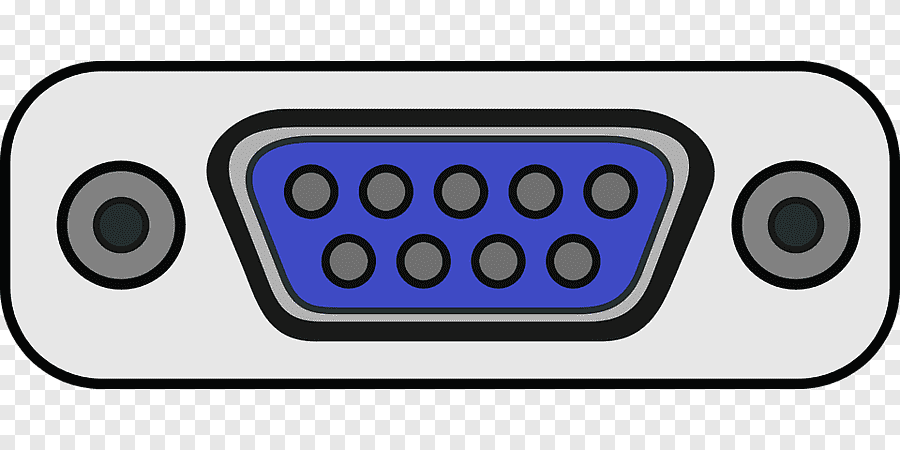
 Design with RS 232 in Cirkit Designer
Design with RS 232 in Cirkit DesignerIntroduction
RS-232 is a widely used standard for serial communication that defines the electrical characteristics, signal timing, and physical interface for data exchange. It is primarily used to connect computers to peripherals such as modems, printers, and industrial equipment. RS-232 enables point-to-point communication and is known for its simplicity and reliability in low-speed data transmission.
Explore Projects Built with RS 232
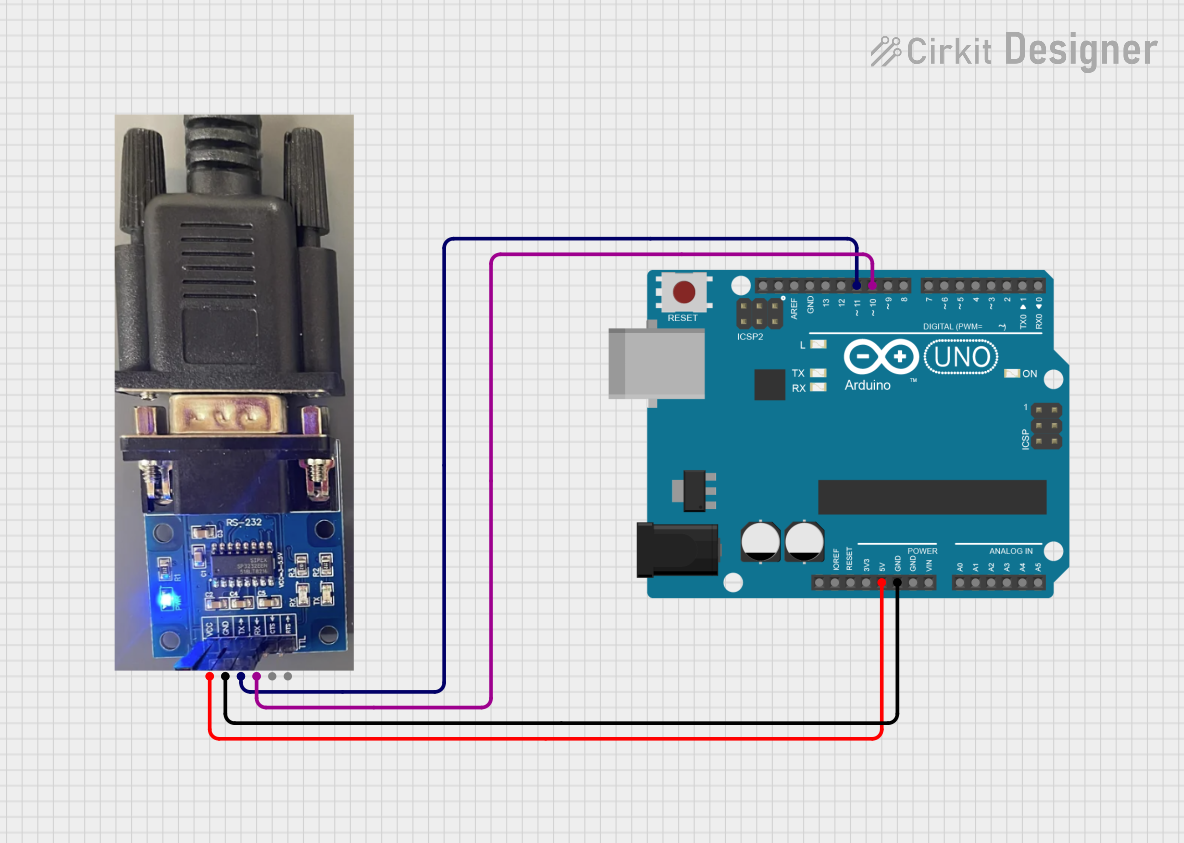
 Open Project in Cirkit Designer
Open Project in Cirkit Designer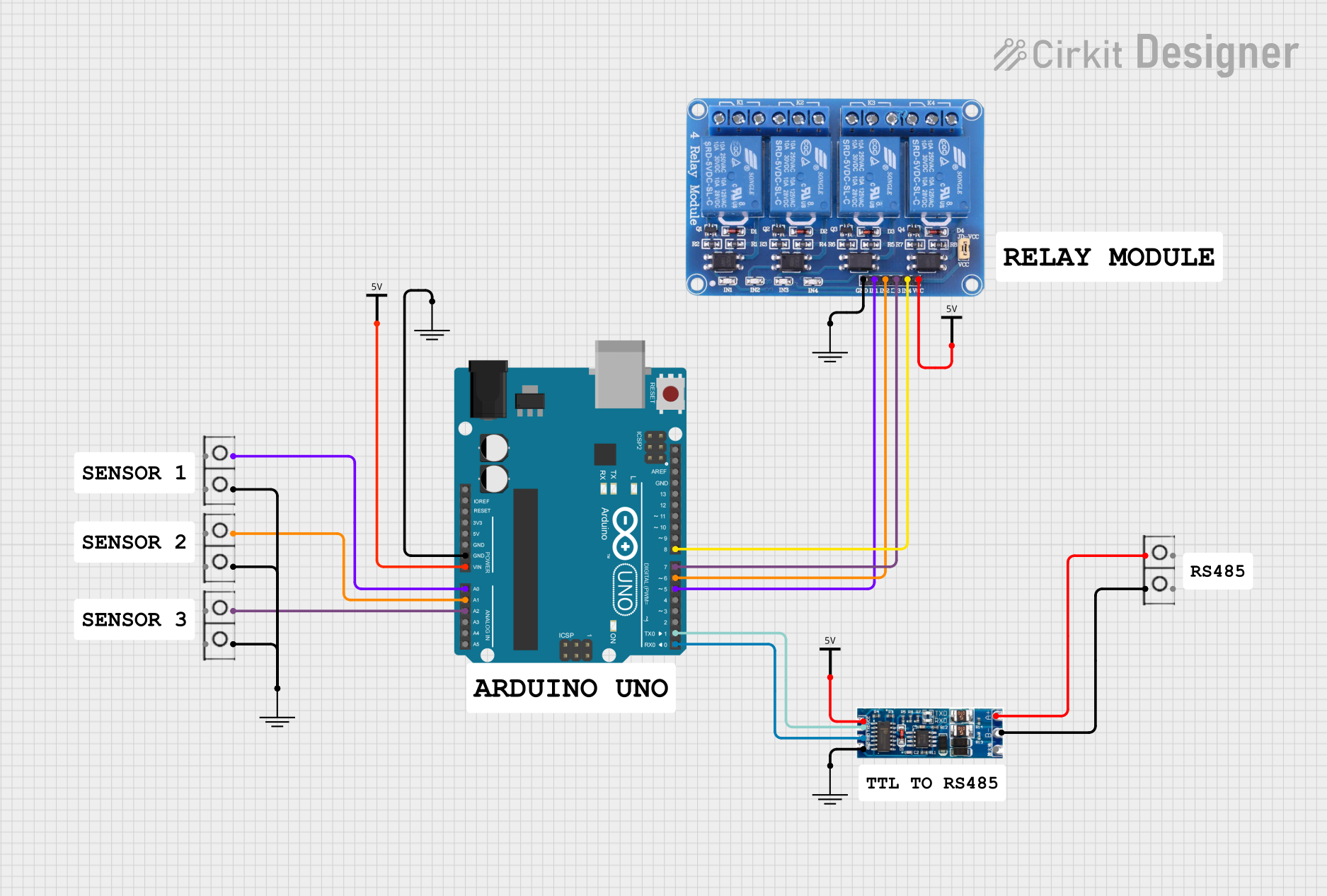
 Open Project in Cirkit Designer
Open Project in Cirkit Designer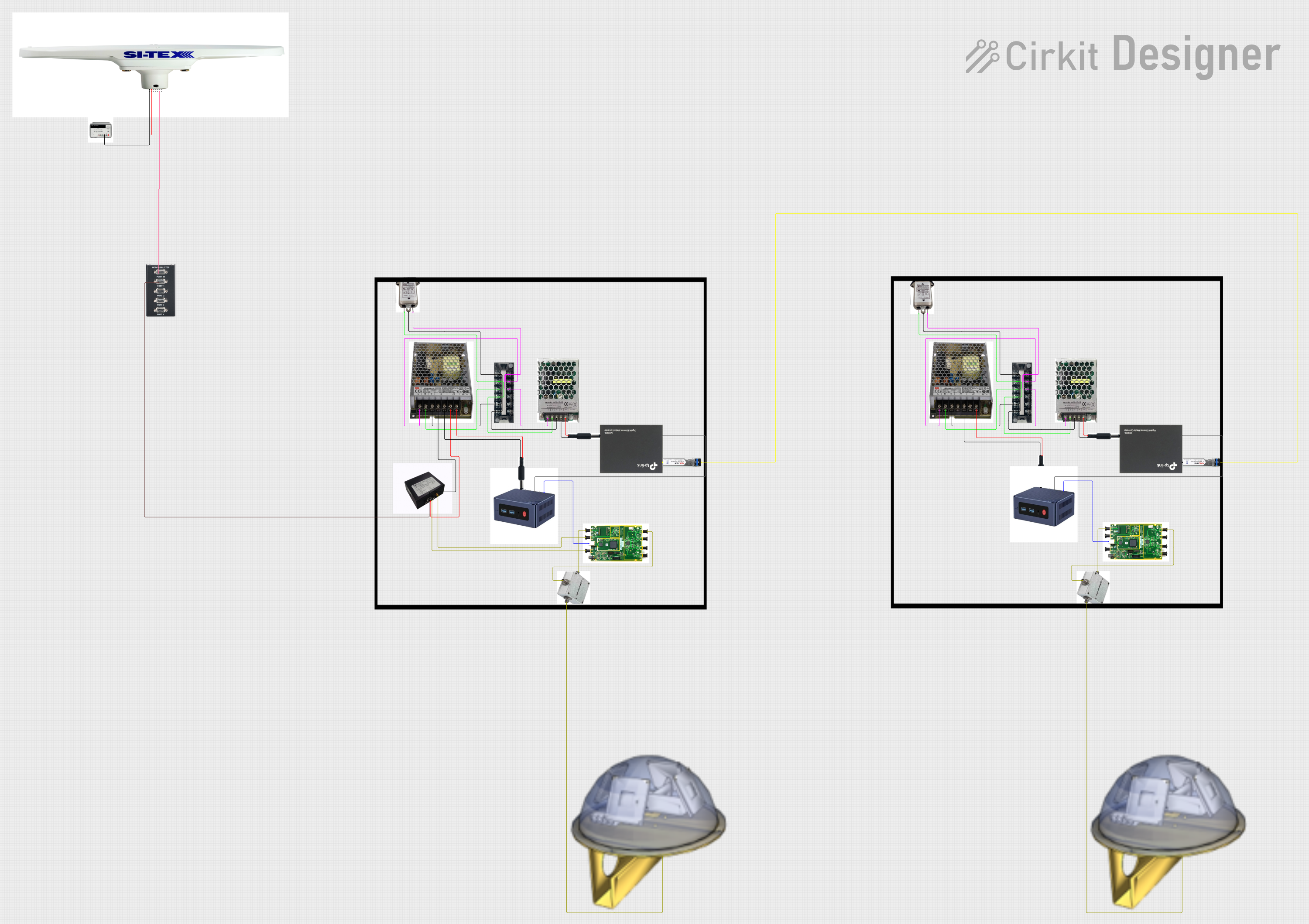
 Open Project in Cirkit Designer
Open Project in Cirkit Designer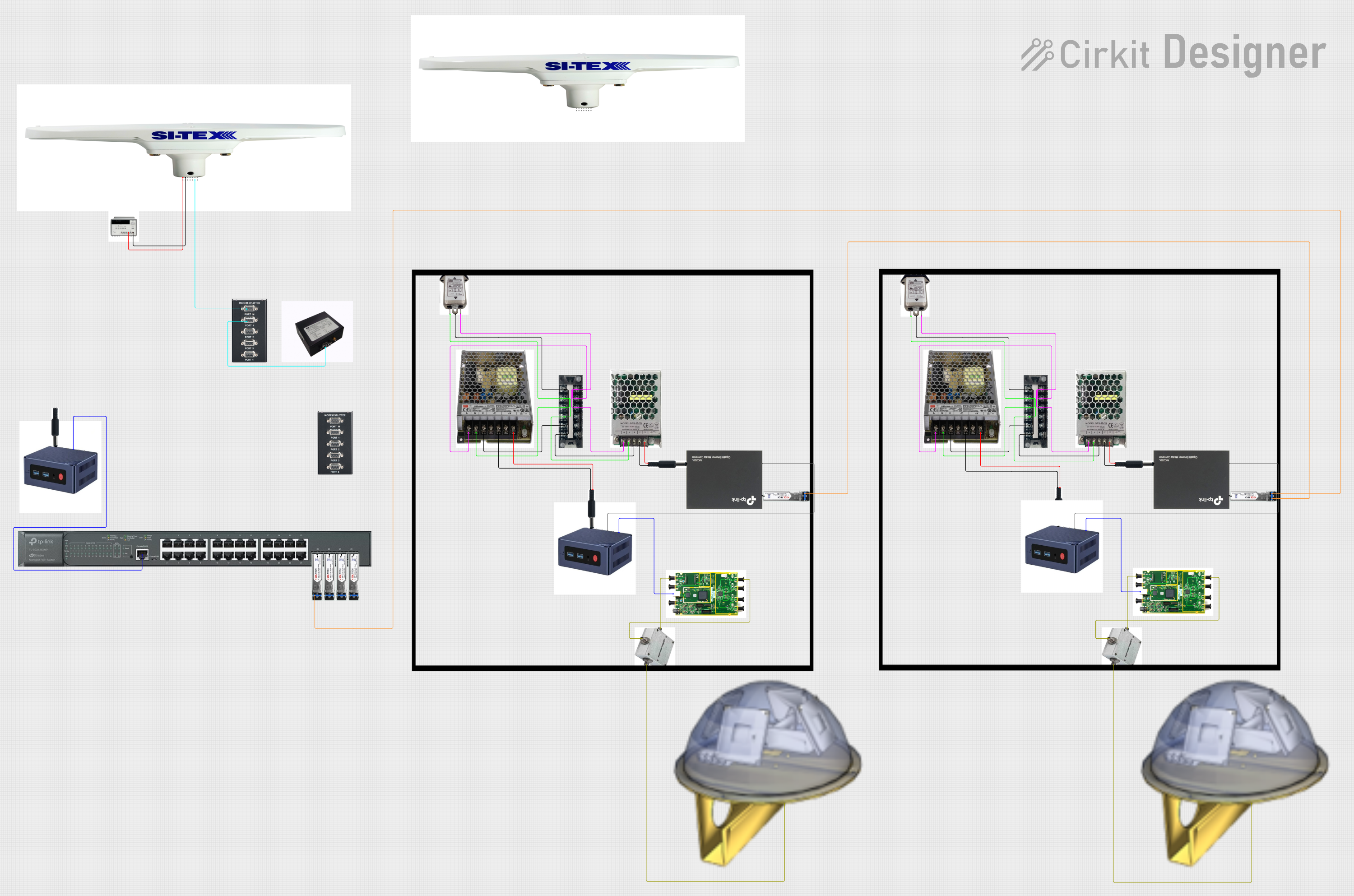
 Open Project in Cirkit Designer
Open Project in Cirkit DesignerExplore Projects Built with RS 232

 Open Project in Cirkit Designer
Open Project in Cirkit Designer
 Open Project in Cirkit Designer
Open Project in Cirkit Designer
 Open Project in Cirkit Designer
Open Project in Cirkit Designer
 Open Project in Cirkit Designer
Open Project in Cirkit DesignerCommon Applications and Use Cases
- Connecting computers to modems for data transfer
- Industrial automation and control systems
- Serial communication with microcontrollers and embedded systems
- Debugging and programming devices
- Communication with legacy hardware
Technical Specifications
Key Technical Details
- Voltage Levels: ±3V to ±15V (typical ±12V for data signals)
- Baud Rate: Up to 115,200 bits per second (bps) (varies by implementation)
- Signal Type: Unbalanced (single-ended)
- Maximum Cable Length: 15 meters (50 feet) at 19,200 bps (longer distances possible at lower speeds)
- Connector Types: DB9 (9-pin) and DB25 (25-pin) are the most common
- Communication Mode: Full-duplex (simultaneous bidirectional communication)
Pin Configuration and Descriptions
DB9 Connector Pinout
| Pin Number | Name | Direction | Description |
|---|---|---|---|
| 1 | DCD (Data Carrier Detect) | Input | Indicates the presence of a carrier signal from the modem. |
| 2 | RXD (Receive Data) | Input | Data received by the device. |
| 3 | TXD (Transmit Data) | Output | Data transmitted by the device. |
| 4 | DTR (Data Terminal Ready) | Output | Indicates the device is ready to communicate. |
| 5 | GND (Ground) | - | Signal ground. |
| 6 | DSR (Data Set Ready) | Input | Indicates the modem is ready to communicate. |
| 7 | RTS (Request to Send) | Output | Indicates the device is ready to send data. |
| 8 | CTS (Clear to Send) | Input | Indicates the modem is ready to receive data. |
| 9 | RI (Ring Indicator) | Input | Indicates an incoming call (used in modems). |
DB25 Connector Pinout (Subset)
| Pin Number | Name | Direction | Description |
|---|---|---|---|
| 2 | TXD (Transmit Data) | Output | Data transmitted by the device. |
| 3 | RXD (Receive Data) | Input | Data received by the device. |
| 4 | RTS (Request to Send) | Output | Indicates the device is ready to send data. |
| 5 | CTS (Clear to Send) | Input | Indicates the modem is ready to receive data. |
| 7 | GND (Ground) | - | Signal ground. |
Usage Instructions
How to Use RS-232 in a Circuit
- Connect the RS-232 Device: Use a DB9 or DB25 cable to connect the RS-232 device to the host (e.g., computer or microcontroller).
- Match Voltage Levels: Ensure the RS-232 voltage levels are compatible with the connected device. If interfacing with a microcontroller, use a level shifter (e.g., MAX232) to convert RS-232 signals to TTL levels.
- Configure Communication Parameters: Set the baud rate, parity, data bits, and stop bits to match the settings of the connected device.
- Establish Communication: Use appropriate software or firmware to send and receive data over the RS-232 interface.
Important Considerations and Best Practices
- Cable Length: Keep the cable length within the standard limit to avoid signal degradation.
- Grounding: Ensure proper grounding to prevent noise and communication errors.
- Signal Integrity: Use shielded cables in noisy environments to maintain signal quality.
- Level Shifting: When interfacing with microcontrollers, use an RS-232 to TTL converter (e.g., MAX232 IC).
Example: Connecting RS-232 to Arduino UNO
To connect an RS-232 device to an Arduino UNO, use a MAX232 IC to convert RS-232 signals to TTL levels. Below is an example Arduino sketch for basic serial communication:
// Example: RS-232 Communication with Arduino UNO
// This code reads data from the RS-232 device and sends it to the Serial Monitor.
void setup() {
Serial.begin(9600); // Initialize Arduino's serial communication at 9600 bps
Serial1.begin(9600); // Initialize RS-232 communication via Serial1 (if using a board
// with multiple UARTs, e.g., Arduino Mega)
}
void loop() {
// Check if data is available from the RS-232 device
if (Serial1.available()) {
char receivedChar = Serial1.read(); // Read a character from RS-232
Serial.print("Received: "); // Print the received character to Serial Monitor
Serial.println(receivedChar);
}
// Check if data is available from the Serial Monitor
if (Serial.available()) {
char sendChar = Serial.read(); // Read a character from Serial Monitor
Serial1.write(sendChar); // Send the character to the RS-232 device
}
}
Note: If using an Arduino UNO, you will need a software serial library (e.g.,
SoftwareSerial) since the UNO has only one hardware UART.
Troubleshooting and FAQs
Common Issues and Solutions
No Communication Between Devices
- Cause: Mismatched baud rate or communication settings.
- Solution: Verify and match the baud rate, parity, data bits, and stop bits on both devices.
Data Corruption or Noise
- Cause: Long cable length or noisy environment.
- Solution: Use shorter, shielded cables and ensure proper grounding.
RS-232 Device Not Detected
- Cause: Incorrect wiring or faulty cable.
- Solution: Double-check the pin connections and test with a known working cable.
Voltage Level Mismatch
- Cause: Direct connection of RS-232 to TTL-level devices.
- Solution: Use a level shifter (e.g., MAX232) to convert voltage levels.
FAQs
Q: Can RS-232 be used for multi-device communication?
A: No, RS-232 is designed for point-to-point communication between two devices.Q: What is the maximum data rate for RS-232?
A: The standard supports up to 115,200 bps, but actual performance depends on the implementation and cable quality.Q: Can I use RS-232 with modern computers?
A: Many modern computers lack RS-232 ports, but USB-to-RS-232 adapters are widely available.Q: How do I test an RS-232 connection?
A: Use a loopback test by connecting TXD to RXD and sending data to verify the connection.